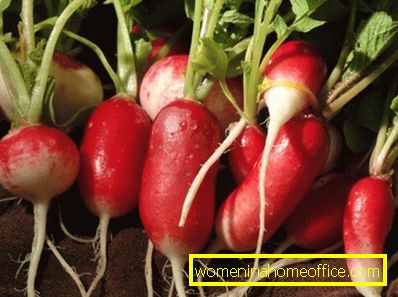Spring vegetable radish
Radish is for many a real salvation from the spring of vitamin deficiency. This bitterish-tasting vegetable belongs to the cabbage family. The name of the plant in Latin is translated as "root". Researchers have determined that radishes come from Central Asia. It was brought to Russia from Holland in the 17th century, during the time of Peter I.
Today in the menu you can find many dishes that include radishes. The benefits and harms of the red root are not known to everyone - let's try to fill this gap.

Can I get better from radish: calorie content of the product
Today, over 20 varieties of radish are known. This vegetable is often recommended for those who set a goal to lose weight. Radish fell into the category of slimming products due to its low calorie content. 100 g of this root contains no more than 20 kcal. It also contains water (93 g). Protein accounts for 1.3 g, while fats are practically absent - 0.2 g.
The energy ratio of proteins, fats and carbohydrates is expressed by the formula: 24%: 5%: 68%. So feel free to enjoy radishes without worrying about gaining extra pounds! However, it is a question of using just fresh radishes. Calorie salad with mayonnaise (or sour cream), which includes a bitter root vegetable, will be much higher.
Garden radish: vitamins, minerals and other benefits!
The Chinese have a proverb: "In winter, eat ginger, and in summer - radishes, and you will be healthy all year!". Eastern wisdom is right. Nature tried and supplied the red-white vegetable with a variety of vitamins: B1, B2, B9. Radish contains ascorbic acid, which is known to help the body resist infectious diseases.
One small root vegetable contains the whole set of necessary elements, such as potassium, calcium, sodium, zinc, magnesium, phosphorus, iron and copper. An unsophisticated vegetable can also boast the presence of retinol (vitamin A) and niitsiana (PP). Mustard oil gives bitter taste to vegetable.
After a long winter, when there are not many vitamins on the table, such a source of health is extremely necessary for the body to wait for a new crop of vegetables and fruits.
The benefits of radish: tops and roots

The long-awaited and tasty guest on our table is radish. Useful properties of this natural product are recommended for those who suffer from the following health problems.
- Obesity. Low-calorie radish will provide the body with the necessary energy and vitamins, but will not allow to recover.
- Intestinal disorders. Radish salad improves peristalsis and promotes normal bowel movement.
- Radish contains a large amount of fiber (almost twice as much as other vegetables), which has a beneficial effect on the work of the stomach.
- Diabetes. Radish is able to regulate blood sugar.
- Cancer Prevention. Radish contains anocyanas, these components prevent the formation of malignant tumors.
- Reduced appetite. Radish causes the stomach to intensively produce gastric juice.
- Unpleasant smell from the mouth. The root crop is rich in essential oils - this gives the product antibacterial properties.
- Impaired immunity. Specific substances - phytoncides contained in radishes are similar in their effect to antibiotics. That is, radishes will help to quickly recover those who have caught a cold or an infectious viral disease.
- Headache.
- Mental and physical exhaustion.

Radish is useful to those who are going on nature or hiking. In the treatment of wounds, this vegetable will successfully fulfill the role of iodine or brilliant green, as it has antiseptic characteristics.
A salad with radish will supply the body with a daily dose of ascorbic acid and saturate the cells with important macro-and microelements for health.
Most citizens nowadays have marked iodine deficiency. To overcome this (and other) health problems will help tasty medicine from the garden - radish. This vegetable is rich in iodine, so it improves memory and attention. Turn the radish on the menu - and the children will get good marks at school, and their behavior will be exemplary.
Although many people put radishes in a salad, the benefits and harm to the body of this plant are far from completely known to them. So, most of the hostes out of habit cut the tops and throw away. Meanwhile, it can be eaten. Experts say that the foliage should be dried and used in winter as a seasoning, giving the original taste to many dishes. The botva is useful for marinades. If you use it for preservation, the brine will acquire a pleasant aroma and spicy sharpness.
An infusion made from radish tops is an effective laxative. Such a folk medicine will help to cope even with protracted constipation. Tincture can also be used as antifungal, hemostatic and anti-inflammatory agent.
Useful properties of radish are used even in cosmetology! If you make a mask that includes the root itself and the tops, then it will help to open the pores and give the face freshness and blush.
So that this bright root vegetable warms the heart and gives strength (this is how the great reformer Peter I described its useful properties), use it correctly and do not keep it for too long.